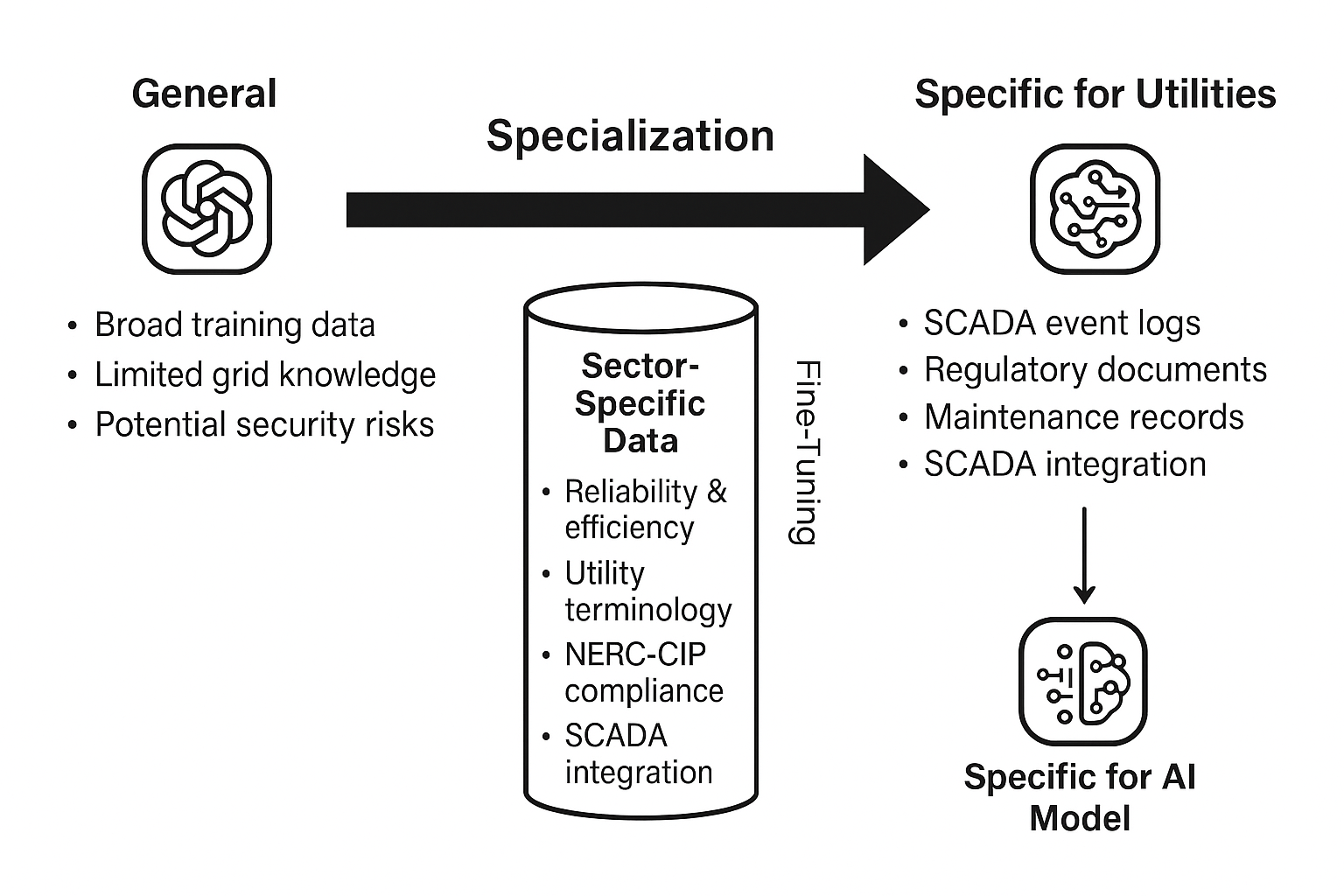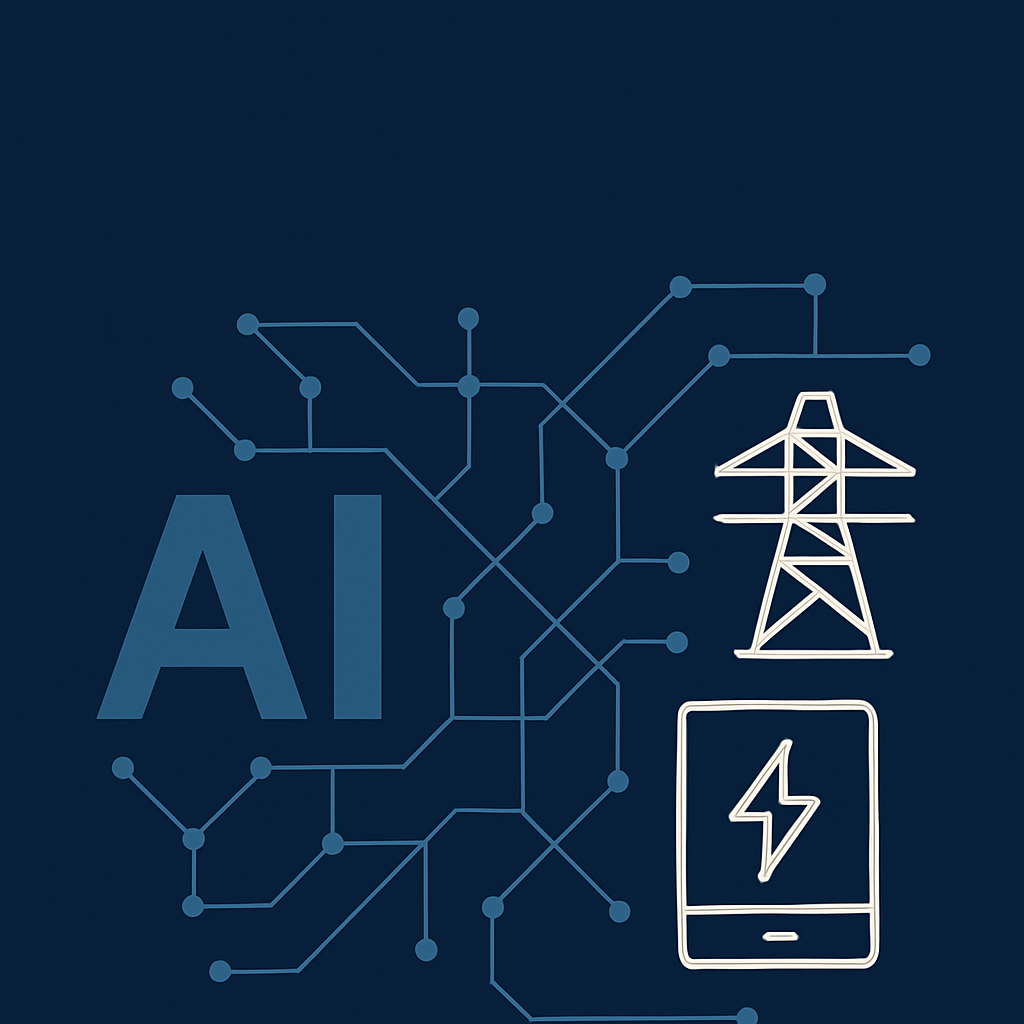Utilities are adopting fine-tuned AI models trained on sector-specific data to avoid costly misinterpretations, integrate securely with grid systems, and deliver gains in reliability, efficiency, and decision-making that general-purpose LLMs cannot match.
On the surface, a large language model like GPT-4, Claude, or Gemini can appear omniscient—capable of answering nearly any question with speed and eloquence. These models are trained on vast libraries of public information, from literature to code to news reports. Yet, inside the high-stakes environment of an electric utility control room, that breadth can be a liability.
In power system operations, the meaning of a single word can carry consequences. A casual misinterpretation of “trip” could imply a short journey in everyday conversation but, in grid operations, it means the sudden disconnection of a line or generator—a potentially costly or dangerous event. “Islanding” might conjure tropical images for the uninitiated; for a system operator, it signals an isolated section of the grid running independently, a delicate and sometimes risky condition. In such a context, ambiguity is not an option.
This is why utilities and their technology partners are turning to industry-specific large language models—fine-tuned versions of general-purpose LLMs, trained on the vocabulary, data, and compliance frameworks unique to the sector. These models are not just better conversationalists; they are trained to think in kilowatts, outages, dispatch signals, and regulatory clauses.
From General to Grid-Specific
Fine-tuning starts with data—specialized datasets drawn from SCADA event logs, IEEE research archives, FERC and NERC regulatory documents, maintenance records, and engineering reports. The goal is to build a language model that is fluent in the technical lexicon and operational patterns of the utility world.
Security is another pillar. Regulated industries cannot afford to send sensitive operational data to open, uncontrolled environments. Many deployments take place on-premises or in secure, private cloud environments, where access is tightly controlled. Alignment with NERC-CIP standards is a baseline, not an afterthought.
These fine-tuned models are also engineered to work within existing utility workflows. They integrate with SCADA, GIS mapping tools, AMI analytics, and load forecasting systems—not as external consultants but as embedded, API-driven team members. And unlike their generalist cousins, they are optimized for specific, high-value tasks: power system optimization, DER integration guidance, asset failure prediction, and compliance reporting.

Proof in the Control Room
The clearest example to date is eGridGPT, developed by the National Renewable Energy Laboratory in collaboration with the University of Michigan, the Lower Colorado River Authority, and Oregon State University. Designed for the grid control room, eGridGPT interprets operational data, runs physics-based digital twin simulations, and generates decision-support recommendations—always with a human operator in the final control loop.1
The approach is mirrored in the private sector. Schneider Electric has applied AI to load forecasting, energy management, and digital twin creation for infrastructure-intensive operations such as AI data centers. Working with Nvidia, Schneider has achieved a reported 20 percent reduction in cooling energy use and 30 percent faster project development for high-density compute facilities.2 These are measurable, operational gains—precisely the kind of outcome that makes AI adoption in utilities compelling.
Barriers to Scale
While the promise is clear, adoption is not without friction.
- Data availability remains a hurdle; proprietary utility data is valuable but often siloed, and labeling it requires experts who understand the operational nuances.
- Computational cost can be significant—full model training is often infeasible, pushing most toward fine-tuning as a cost-effective compromise.
- Trust and explainability are essential; an AI’s recommendation must be auditable, especially in regulated environments where a wrong decision can trigger compliance violations.
- Integration complexity with legacy systems means deployment is as much an IT challenge as an AI one.
How Utilities Can Proceed
A successful implementation often follows a staged approach:
- Define use cases with clear business value, such as automating compliance reports or optimizing outage responses.
- Curate datasets that combine proprietary operational logs with trusted public sources, ensuring regulatory compliance in handling sensitive data.
- Select the model—either fine-tune an existing LLM or build a custom one for highly sensitive applications.
- Train and evaluate the model using supervised learning and reinforcement learning with human feedback (RLHF).
- Deploy securely via private cloud or on-premises systems, embedding AI governance into day-to-day operations.
Research Momentum
Multiple initiatives are already expanding the knowledge base:
- NREL’s eGridGPT project integrates AI into real-time operational decision-making.
- A Texas A&M University study explores LLM applications in power flow analysis, forecasting, and specialized knowledge bases.
- ComEd’s Grid Analytics team is developing AI tools to enhance operational efficiency and automation.
Emerging Applications
As these models mature, new utility-specific use cases are emerging:
- Grid Management: Real-time analytics to anticipate and resolve operational anomalies.
- Predictive Maintenance: Asset failure forecasting to reduce unplanned outages.
- Energy Demand Forecasting: Advanced prediction models to optimize resource allocation.
- Energy Management – Building-level energy optimization for cost and efficiency gains.
Looking Ahead
The adoption curve for industry-specific LLMs in utilities may be gradual, but the trajectory is clear. From early pilots to embedded operational tools, fine-tuned AI is beginning to occupy a role in grid management that is as indispensable as SCADA systems or GIS maps. With proper governance, secure integration, and targeted training, these models are on track to become standard components of the utility technology stack—capable of delivering operational efficiency, enhanced reliability, and better customer outcomes.
Shailesh Jain is a Principal Advisor at SCE with 30+ years in T&D, specializing in strategic asset planning and risk-based strategies to enhance grid reliability and resilience. He leads cross-functional efforts advancing energy transition and modern grid solutions. He can be reached at https://www.linkedin.com/in/sjain-smartgrid/.
Join the AI×Energy Community — Before You’re Playing Catch-Up
The digital infrastructure revolution is not just moving fast—it is rewriting the rules of energy, finance, and technology in real time. If this deep dive into data-center finance opened your eyes, imagine having direct access to the next wave of intelligence before it hits the headlines.
Subscribe to AI×Energy—free—for the same insider-level analysis, exclusive briefings, and system-level roadmaps trusted by leaders in energy, AI, and infrastructure. You will be joining hundreds of executives, investors, and technologists who rely on AI×Energy to anticipate capital flows, decode regulatory shifts, and spot the hidden forces shaping tomorrow’s grid.
Do not read about the future secondhand—own the playbook.
References
- National Renewable Energy Laboratory. eGridGPT: Trustworthy AI in the Control Room. Golden, CO: NREL, 2024. https://www.nrel.gov/docs/fy24osti/87740.pdf
- Business Insider. “As AI Surges, Schneider Electric Is Teaming Up with Nvidia to Help Companies Build Data Centers That Can Handle AI’s Energy Demands.” July 16, 2025. https://www.businessinsider.com/schneider-electric-nvidia-ai-data-centers-designs-energy-demands-2025-7
- Texas A&M Engineering. “Large Language Models May Revolutionize the Electric Energy Sector.” June 24, 2024. https://engineering.tamu.edu/news/2024/06/large-language-models-may-revolutionize-the-electric-energy-sector.html
- Utility Analytics Institute. “Large Language Models and Grid Analytics.” 2024. https://utilityanalytics.com/large-language-models-grid-analytics/
- Salesforce. “Artificial Intelligence in Utilities.” 2024. https://www.salesforce.com/energy-utilities/artificial-intelligence-utilities/
- TRC Companies. “Benefits of AI and Machine Learning for Utility Companies.” 2024. https://www.trccompanies.com/insights/benefits-of-ai-and-machine-learning-for-utility-companies/
- Master of Code. “Generative AI in Energy and Utilities.” 2024. https://masterofcode.com/blog/generative-ai-in-energy-and-utilities
- Verdigris Technologies. “Energy Management Platform.” 2024. https://www.verdigris.co/



